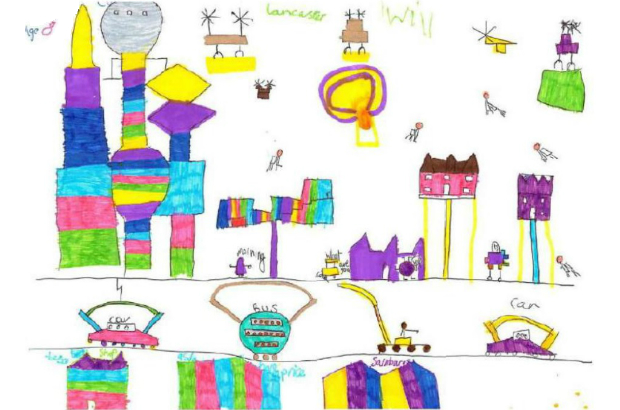Guest post by John Regan from Lancaster Chamber of Commerce.

Last year we asked young people to write and/or draw their ideas for what Lancaster will or should be like in 2065. Once the entries were collected, the Chamber put together a report collating exactly how Lancaster’s young people see the future of our city, which we are now sharing with the world.
There was one thing we made clear from the project’s onset. This isn’t the kind of perfunctory consultation where we ask for people’s ideas, give them a pat on the head (or for 6 lucky people, a 16 GB iPad mini), and let everything sit on a shelf. Having read the report, Michael Greenhalgh from Lancaster Vision remarked "we believe that the exercise has been extremely valuable as much for where it might lead as for its immediate results".
Some of the more immediate results included Jennifer Milligan, Lancaster City Council, sharing the report findings with the Council’s customer insight group, Lancaster District community engagement practitioners group and Lancaster University project. As the council’s Consultation and Engagement Officer, Jennifer has subsequently reflected on targeting different age groups with different consultation and communication methods, including developing social media strategies.

Probably the most substantial result of the report stems from feedback from Andrew Dobson, Head of Regeneration and Planning, and Anne Marie Harrison, Economic Development Manager, both of Lancaster City Council. Both Andrew and Anne Marie were especially interested in how the older participants gave intelligent, critical analyses of future issues while producing refreshingly novel ideas; or as Michael Greenhalgh said, the "best combination of imagination and feasibility in the context of cities". As a result, they believed that consulting 16 to 18 year olds would maximise the positive impact young people’s ideas could have on local policy.
This is why at the Chamber we are going to incorporate this consultation into our plans for a Youth Chamber. The aim of the Youth Chamber is to help young people aged 16 to 18 develop the skills necessary for the workplace, help them get to grips with entrepreneurialism and introduce them to local business contacts. Not only will this prepare our city’s young people for the future; it will also benefit local businesses by giving them the skilled workers much needed in this district.
Another crucial aspect of the Youth Chamber, and one that ties more directly with the Lancaster Future of Cities project, will be to consult them as we would do with our grown-up Chamber members, engaging them in critical conversations about local issues and feeding this back to local government. As Andrew Dobson commented in his feedback of the Future of Cities report:
"The local community has a choice of the direction of travel it wants to pursue. It is clear however that choices by one generation of that community might be different than, or prejudice the future of another generation. Without knowing what the young people of the district want, or whether they realise that one version of the future is being prepared for them without their engagement, incorrect choices could be made."

The Future of Cities has been an opportunity to engage young people in thinking about the part of their future that is often decided for them without their engagement. I recall very clearly engaging in an environmental science project at the age of 14 which featured a strong emphasis on Town Planning and it played a large part in leading me into the career I subsequently chose. Engagement properly devised, made relevant and exciting, can inspire even at early ages.
Childhood is for childhood and is precious because of this, but young people have aspirational thoughts about their futures, and there comes a time when these should be taken into account by those tasked with making decisions about the future. There has been no better example that the current housing situation which has been heavily influenced by the Baby Boom generation without much thought given to those generations who follow. Would it be so easy to take the views that some in society do if a more vocal and informed younger generation had become engaged in the planning and place shaping process so much earlier?
The Future of Cities project has drawn out some wonderful ideas from young people with quite a different perspective on the modern world, unimpeded by the constraints of budgets, commercial viability and convention. These nevertheless also pay homage to some of the best ideals of sustainability and morality, caring for the community and good design.
I hope and am very optimistic that some of those engaged in this process might become the Town Planners of the future, and let’s hope that some well meaning educator doesn’t mislead them into doing a geography degree rather than a specialist Town Planning one.
The Lancaster Future of Cities project has undoubtedly been a catalyst in empowering young people to make a positive contribution to their city; the project is just the beginning of a better future for Lancaster.
All images courtesy of Lancaster Chamber of Commerce.
Sign up for email alerts from this blog, or follow us on Twitter.
